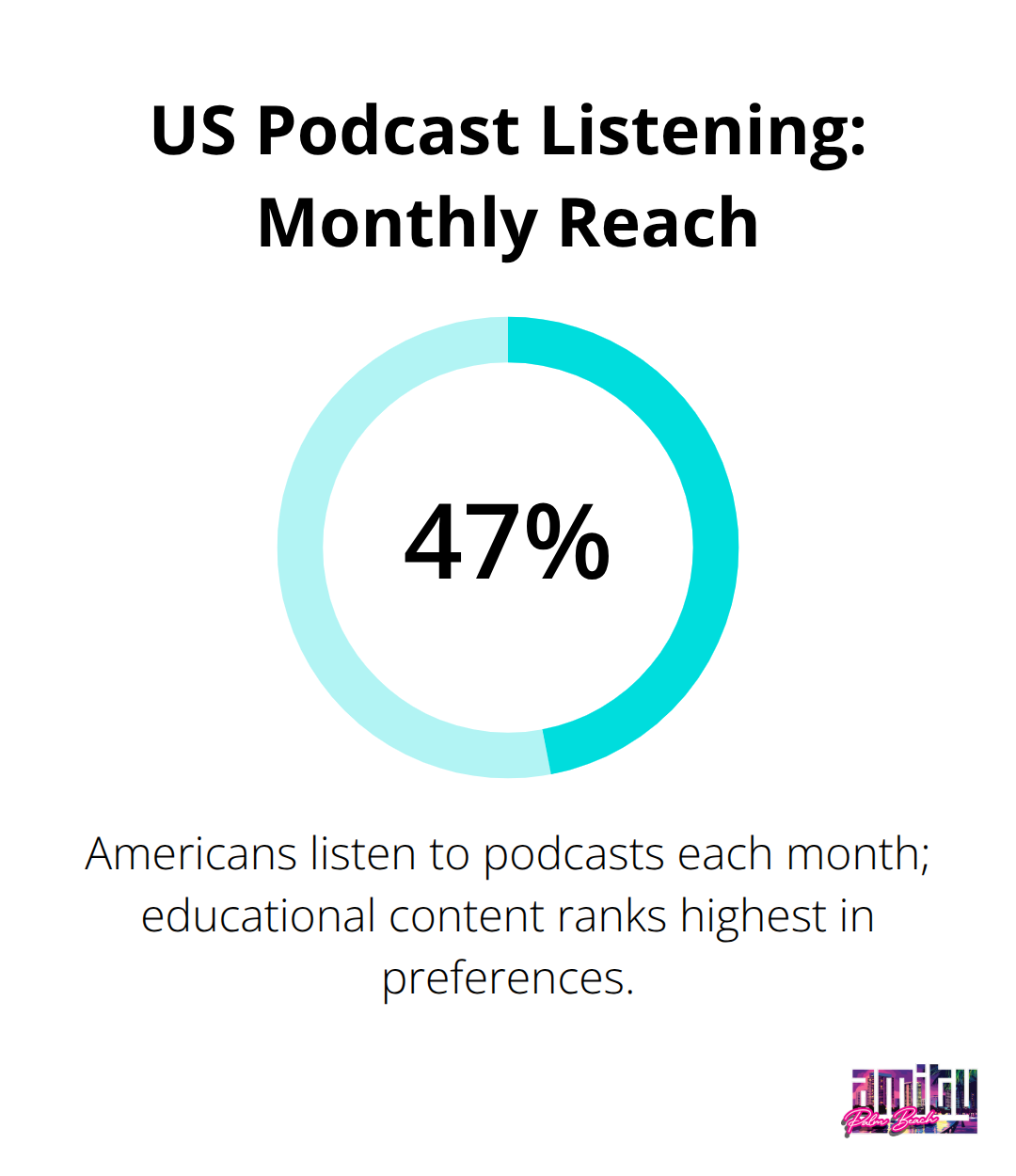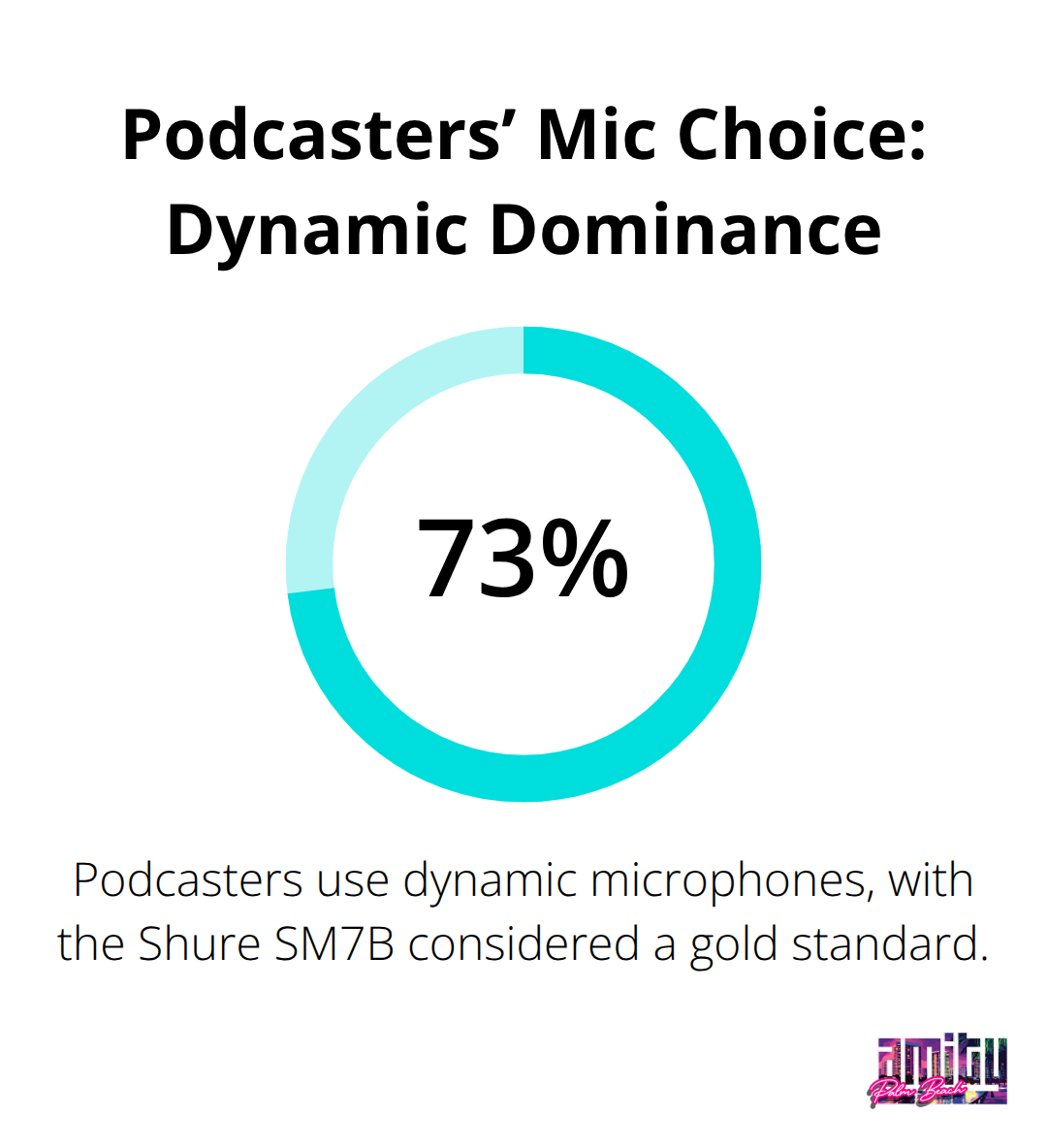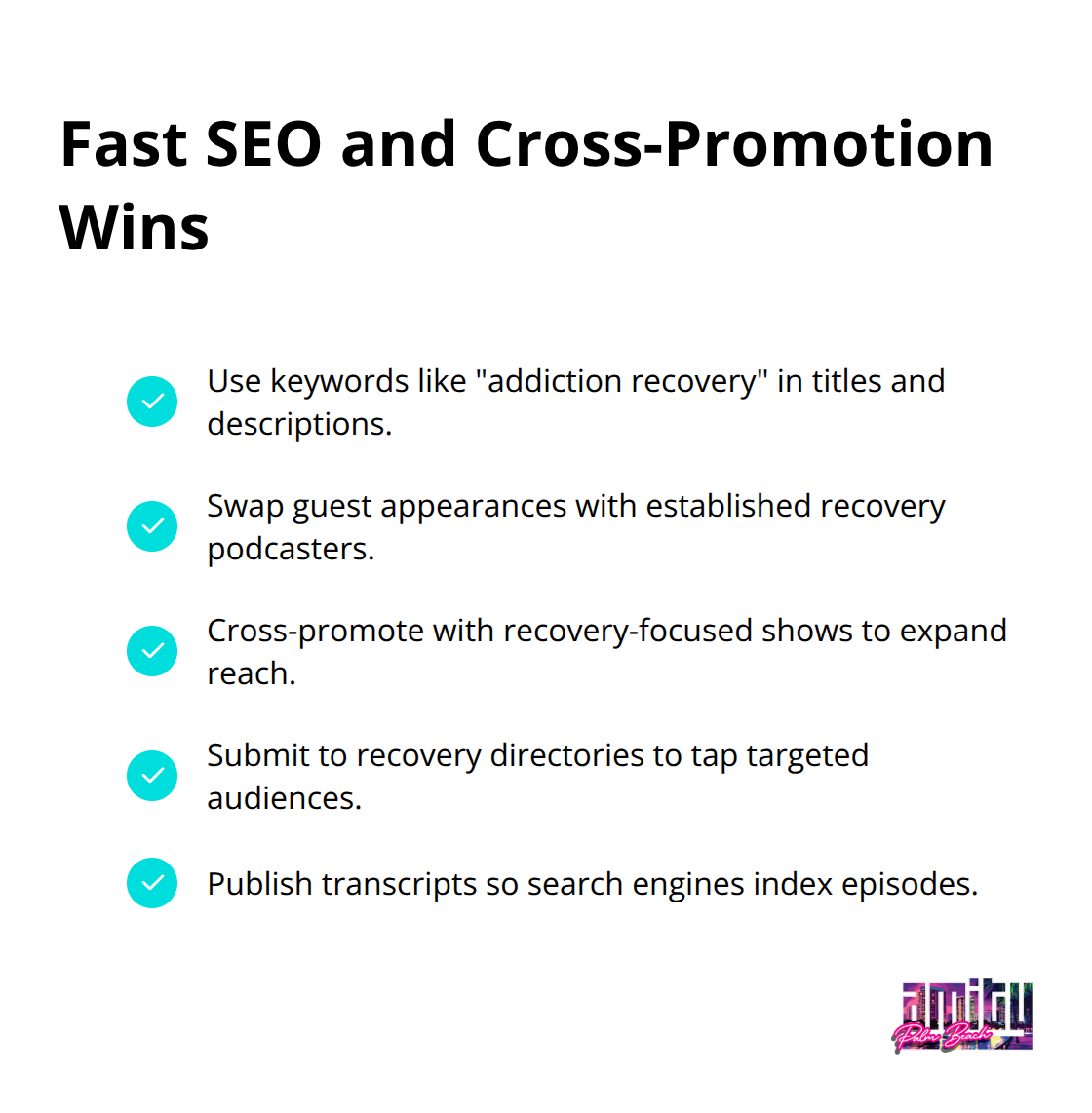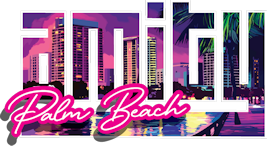Starting a podcast about addiction recovery can transform lives and build meaningful connections within the recovery community. The medium offers an intimate platform to share authentic stories and practical guidance.
We at Amity Palm Beach understand the power of storytelling in recovery. This guide walks you through every step needed to launch your own recovery-focused podcast successfully.
What Makes Your Recovery Podcast Stand Out
Successful recovery podcasts target specific audiences rather than attempt to reach everyone. Edison Research found that 47% of Americans listen to podcasts monthly, with educational content ranking highest in listener preferences. Focus on a narrow niche within recovery – whether that’s professionals in recovery, families affected by addiction, or young adults who navigate sobriety. The Recovery Show built their audience through specific targeting of people in 12-step programs, while The Addicted Mind Podcast focuses on scientific approaches to treatment.
Identify Your Core Audience
Recovery professionals, family members, and people in early sobriety each need different content approaches. Professionals might want episodes about how to maintain sobriety while they manage high-stress careers. Families often seek guidance on how to support loved ones without they enable destructive behaviors.

People in early recovery typically respond to practical tips for how to manage cravings and build new routines. Survey existing recovery communities on Facebook or Reddit to understand what topics generate the most engagement and questions.
Select Formats That Work
Interview-based formats dominate successful recovery podcasts because personal stories create stronger connections than solo commentary. The Let’s Talk Addiction and Recovery podcast averages 45-minute episodes with guest interviews, while shorter 20-minute solo episodes work better for daily inspiration content. Consistency matters more than length – weekly releases build stronger audience habits than sporadic longer episodes. Mix formats within your series: guest interviews, expert panels, and listener question episodes create variety while you maintain your core message.
Plan Content for Maximum Impact
Plan content around recovery milestones and seasonal challenges. January episodes should address New Year sobriety goals, while holiday episodes in November and December can focus on how to navigate family gatherings and social drinking situations (these periods often trigger relapse). Create series within your podcast – a four-part series on how to rebuild relationships or manage work stress keeps listeners who return. Partner with addiction treatment professionals for expert perspectives on medical aspects of recovery, but balance clinical information with relatable personal experiences that normalize the recovery journey.
Build Your Production Foundation
Quality audio separates professional podcasts from amateur attempts. The Shure SM7B has become the industry standard for podcast recording, while budget-conscious creators can start with the Audio-Technica ATR2100x-USB ($79). Anchor.fm offers free hosting with automatic distribution to major platforms, though paid services like Libsyn provide better analytics and customization options. Your equipment choices will directly impact how listeners perceive your credibility and whether they continue past the first episode.
What Equipment and Setup Do You Actually Need
Professional audio quality starts with the right microphone, and the Audio-Technica ATR2100x-USB at $79 delivers broadcast-quality sound without you break your budget. The Shure SM7B costs $400 but remains the gold standard that 73% of podcasters use dynamic mics. Skip USB microphones under $50 – they create background noise that drives listeners away within the first 30 seconds. Audacity provides free software that handles everything most recovery podcasters need, while Adobe Audition offers advanced features for $20 monthly.

Your space matters more than expensive equipment – record in a closet full of clothes or hang blankets around your area to eliminate echo and background noise.
Choose Your Platform Wisely
Anchor.fm offers free hosting with automatic distribution to Apple Podcasts, Spotify, and Google Podcasts, which makes it perfect for beginners who want to test their concept. Libsyn costs $15 monthly but provides detailed analytics that show which episodes perform best and where your listeners drop off – data that becomes invaluable for content improvement. Buzzsprout charges $12 monthly and automatically creates transcripts for accessibility, which also boosts your search engine rankings. Avoid hosting on your own website unless you want to handle technical issues instead of focus on content creation. Most successful recovery podcasts switch to paid hosting within six months because free platforms limit your growth and monetization options.
Design Artwork That Builds Trust
Your podcast artwork appears as a tiny square on phone screens, so bold text and simple designs work better than complex graphics. Canva offers podcast artwork templates for free, though custom designs from 99designs cost $200-500 and help you stand out in crowded recovery podcast categories. Include the word “recovery” in your title and artwork because people search specifically for that term. The Recovery Show uses clean typography with calm colors, while The Addicted Mind Podcast features a brain graphic that immediately communicates their scientific approach. Test your artwork – shrink it to thumbnail size and check if you can read the text clearly (if not, redesign it before launch).
Set Up Your Distribution Strategy
Major podcast platforms require different submission processes, but your hosting service handles most technical requirements automatically. Apple Podcasts remains the largest platform with 70.8% market share, followed by Spotify. Submit to Apple Podcasts first because their approval process takes 2-7 days, while other platforms approve within hours. Create accounts on each platform to claim your podcast name and control your listing information. This foundation prepares you to focus on the most important element of podcast success: building genuine connections with your audience through consistent, valuable content.
How Do You Build Your Recovery Podcast Audience
Facebook groups dedicated to addiction recovery provide valuable community support through reputable organizations that offer recovery resources and volunteer opportunities. Post valuable content weekly in these groups – share episode highlights, ask thoughtful questions about recovery challenges, and respond genuinely to comments without promoting your podcast directly. Build authentic relationships within these communities before expanding to Instagram and Twitter. Create your own Facebook group after you reach consistent download numbers because community management requires significant time investment that pays off only with established content.
Partner with Treatment Centers and Professionals
Treatment facilities actively seek educational content for their websites and social media channels, which creates natural partnership opportunities. Reach out to local treatment centers monthly with specific collaboration proposals – offer to create custom episodes about their specialties or interview their clinical directors about treatment approaches. Healthcare marketing leaders understand the power of storytelling to drive positive change in recovery communities. Licensed therapists, addiction counselors, and medical professionals make excellent guests who bring their own audiences and professional credibility to your show.
Optimize for Search and Cross-Promotion
Podcast SEO starts with strategic keyword placement in episode titles and descriptions – terms like “addiction recovery,” “sobriety tips,” and “relapse prevention” generate more organic discovery than generic titles. Collaborate with established recovery podcasters through episode swaps where you appear as a guest on their show while they guest on yours. Cross-promotion with other recovery-focused shows can significantly expand your audience reach. Submit your podcast to recovery-specific directories and create transcripts for each episode – search engines index transcripts, which dramatically improves your discoverability for people who search recovery-related questions online.

Leverage Social Media Platforms Strategically
Instagram Stories and Reels perform better than static posts for recovery content because personal video messages create stronger emotional connections with potential listeners. Post behind-the-scenes content from your recording sessions, share quick recovery tips, and highlight powerful quotes from recent episodes. TikTok reaches younger audiences in early recovery – create short clips that preview longer podcast discussions about topics like social anxiety in sobriety or handling peer pressure. LinkedIn works well for reaching professionals in recovery who prefer discrete, career-focused content about maintaining sobriety in high-stress work environments. Consider exploring addiction treatment resources to better understand your audience’s needs.
Final Thoughts
A podcast about addiction recovery requires strategic planning, quality equipment, and authentic community engagement. You must focus on your specific audience, invest in decent recording equipment, and build relationships within recovery communities before you promote your content. Success comes from consistency and genuine value delivery rather than perfect production quality.
Long-term growth depends on strategic partnerships with treatment professionals and cross-promotion with established recovery podcasters. SEO optimization through keyword-rich titles and episode transcripts increases organic discovery. Social media platforms like Instagram and TikTok help you reach younger audiences, while LinkedIn connects you with professionals who maintain sobriety in demanding careers.
Recovery podcasts create powerful ripple effects beyond download numbers (personal stories reduce stigma and inspire hope for people who struggle with addiction). Your authentic experiences can guide someone through their darkest moments and connect them with resources like addiction treatment programs. The recovery community needs more voices that share real experiences and practical guidance.


